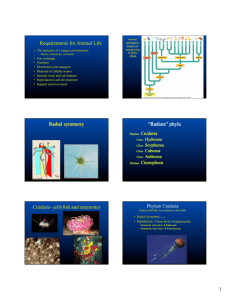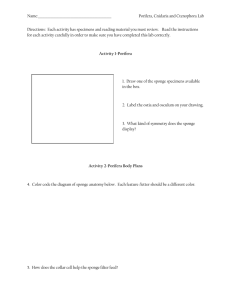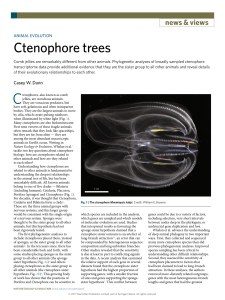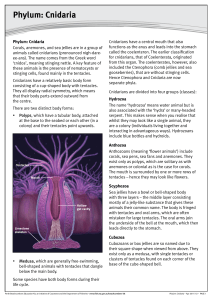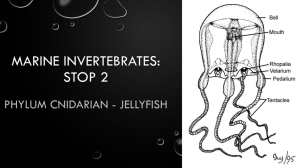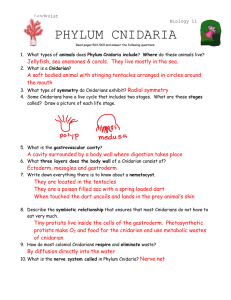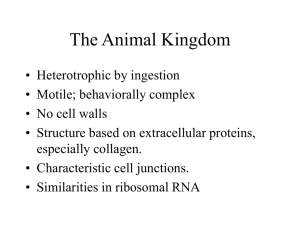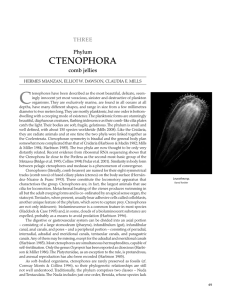Lab
advertisement
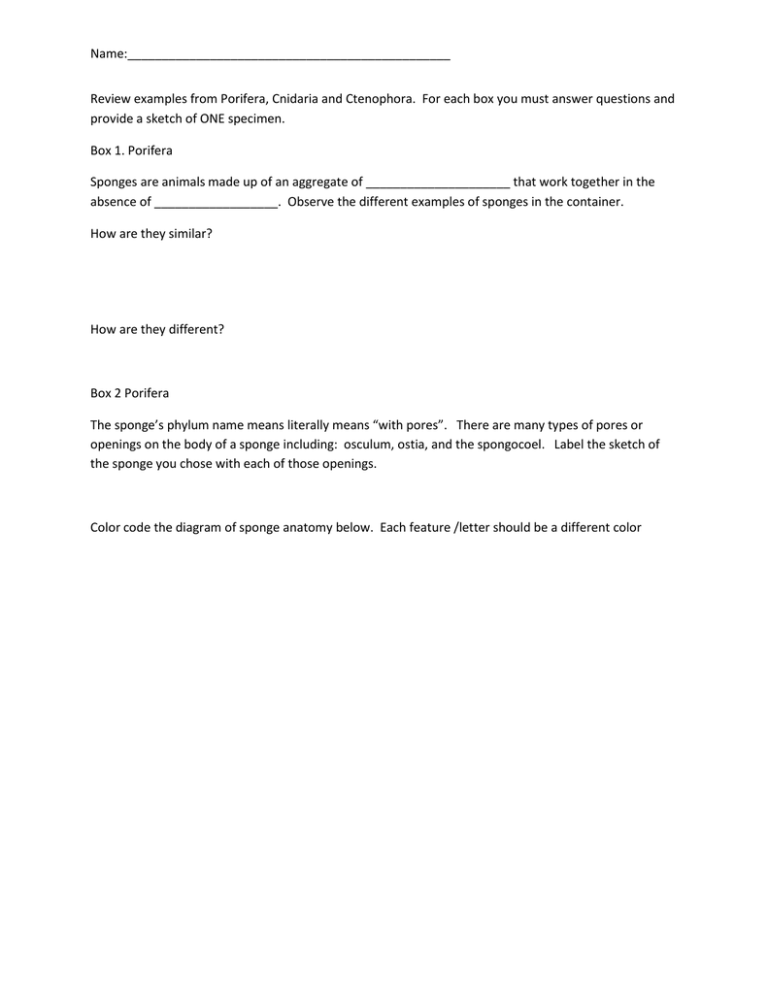
Name:_______________________________________________ Review examples from Porifera, Cnidaria and Ctenophora. For each box you must answer questions and provide a sketch of ONE specimen. Box 1. Porifera Sponges are animals made up of an aggregate of _____________________ that work together in the absence of __________________. Observe the different examples of sponges in the container. How are they similar? How are they different? Box 2 Porifera The sponge’s phylum name means literally means “with pores”. There are many types of pores or openings on the body of a sponge including: osculum, ostia, and the spongocoel. Label the sketch of the sponge you chose with each of those openings. Color code the diagram of sponge anatomy below. Each feature /letter should be a different color Name:_______________________________________________ Box 3. Phylum Cnidaria Class Anthazoa In contrast to anemones…coral are colonial polyps with an exoskeleton. This means that an individual polyp cannot exist on its own and the entire colony is covered in continuous tissue. Each polyp sits in/on a calcium carbonate skeleton that it has excreted and can retract into. What kind of symmetry does coral have? Is it evident in the colony or only in an individual? While corals get 95% of their food from their zooxanthellae how do they feed at night? Box 4 Phylum Cnidaria Class Hydrozoa Some Hydrazoans are colonial jellies like the Portoguese Man-o-War. These colonial hydras can also be called siphonophores. These Cnidarians have a gas filled float used to sail across water while their stinging tentacles trail behind them. Their body is made up of a colony of individuals that live, feed and float together. While one individual feeds the rest are busy with defense or reproduction. How are these similar to “true jellies” or scyphazoa? How are these different? Box 5 Phylum Cnidaria Class Scyphozoa Jellyfish were probably the first animals to swim in the water column. While part of the jellyfish’s life cycle is a bottom dwelling asexual polyp you are more familiar with the mobile planktonic and sexually reproducing medusa. Aurelia is a common genus on the Jersey shore. It has very short tentacles because it is a suspension feeder. Label your sketch of Aurelia with the following terms: aboral, oral, tentacle, bell How does a jellyfish’s shape help it eat? (Hint remember the movie?) Name:_______________________________________________ Box 6 Phylum Cnidaria Class Cubazoa Article: Read the excerpt on Box Jellyfish to answer the questions… Introduction to Cubozoa: http://www.ucmp.berkeley.edu/cnidaria/cubozoa.html The Box Jellies! Cubozoans are marvelous animals. They look like your basic jellyfish, but they can swim pretty fast, maneuver around things, and see fairly well despite not having a brain. Believe it or not. In general, box jellies are similar in form to the "true" jellyfish, known as scyphozoans. However, it is relatively easy to tell the two groups apart. Cubozoans have a square shape when viewed from above. (Gee, maybe that's how they got their name.) They also have four evenly spaced out tentacles or bunches of tentacles and well-developed eyes. Not surprisingly, given their squishy nature, there are not many fossil cubozoans known. Today, there are about 20 known species found in tropical and semitropical waters. The Australian stinger Chironex fleckeri is among the deadliest creatures in the world, having caused human fatalities. 1. What kind of sensory structure are found in this group? 2. How can you tell them apart from “true jellies”? 3. Where is this group found? 4. Why might you not want to meet one in person? Name:_______________________________________________ Box 7. Phylum Ctenophora. Sketch the comb jelly specimen as per instructions and then use the information in the box to answer the questions below. 1. Compare the comb jellies to true jellies SIMILARITIES DIFFERENCES 2. How do these animals capture food without stinging cells? 3. Why is it surprising that there are fossils of this anima group? Name:_______________________________________________ Introduction to Ctenophora Ctenophores (Greek for "comb-bearers") have eight "comb rows" of fused cilia arranged along the sides of the animal, clearly visible along the red lines in these pictures. These cilia beat synchronously and propel ctenophores through the water. Some species move with a flapping motion of their lobes or undulations of the body. Many ctenophores have two long tentacles, but some lack tentacles completely. Ctenophores, variously known as comb jellies, sea gooseberries, sea walnuts, or Venus's girdles, are voracious predators. Unlike cnidarians, with which they share several superficial similarities, they lack stinging cells. Instead, in order to capture prey, ctenophores possess sticky cells called colloblasts. In a few species, special cilia in the mouth are used for biting gelatinous prey. The phylogenetic position of ctenophores has been, and still is, in dispute. Ctenophores have a pair of anal pores, which have sometimes been interpreted as homologous with the anus of bilaterian animals (worms, humans, snails, fish, etc.). Furthermore, they possess a third tissue layer between the endoderm and ectoderm, another characteristic reminiscent of the Bilateria. However, molecular data has contradicted this view, although only weakly. Therefore, this is an active area of research. Although most ctenophores swim, one group creeps along the bottom of the seas. Most of these species live on other animals, for instance with echinoderms, sponges, or benthic cnidarians. Many ctenophores, like various other planktonic organisms, are bioluminescent, able to give off light. Until fairly recently, no fossil ctenophores were known. Like most pelagic cnidarians, the bodies of ctenophores are made up mostly of water, and the chances of leaving a recognizable fossil are very Name:_______________________________________________ slim. Two species of fossil ctenophore have now been found in the Late Devonian, in the famous Hunsrückscheifer slates of southern Germany (Stanley and Stürmer, 1983, 1987). Both owe their preservation to rapid precipitation of pyrite in the tissues, and both are quite similar to living ctenophores in the order Cydippida (the "sea gooseberries.") Other ctenophore-like forms have been found in the Cambrian-age Burgess Shale of the Canadian Rocky Mountains and Chengjiang Formation of Southern China. These forms differ from living ctenophores in several ways, thus obscuring their phylogenetic affinities. Little is currently known about the basic biology of most ctenophores; indeed, the individual in these pictures has not even yet been formally described and named, despite being large, spectacularly colored, and common. These photographs were made available to the UCMP by Underwater World, Queensland, Australia. View the World List of Ctenophora species, arranged in a taxonomic classification, or visit the page on Ctenophora at the Tree of Life. Sources: Stanley, G.D., and W. Stürmer. 1983. The first fossil ctenophore from the Lower Devonian of West Germany. Nature 303:518-520. Stanley, G.D., and W. Stürmer. 1989. A new fossil ctenophore discovered by X-rays. Nature 327:61-63.
